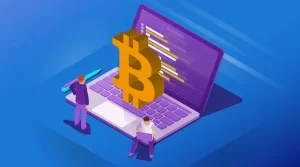Margin trading is a popular trading strategy that allows traders to borrow funds to increase their purchasing power and potentially earn greater profits. In the world of cryptocurrencies, margin trading is offered by many exchanges, but it also comes with significant risks. In this article, we’ll explore the basics of margin trading on crypto exchanges, the potential rewards and risks, and some best practices for managing those risks.
What is Margin Trading?
Margin trading is a trading strategy that allows traders to borrow funds from a broker or exchange to buy assets. The trader provides a certain amount of collateral, such as Bitcoin or Ethereum, and the exchange lends them additional funds to buy more of the asset. This allows the trader to increase their purchasing power and potentially earn greater profits.
How Does Margin Trading Work on Crypto Exchanges?
Margin trading on crypto exchanges works similarly to margin trading on traditional stock exchanges. Traders deposit collateral in the form of cryptocurrency, and the exchange lends them additional funds to buy more cryptocurrency. The trader then pays interest on the borrowed funds and must maintain a certain level of collateral to avoid being liquidated.
Potential Rewards of Margin Trading
Margin trading can potentially result in greater profits than traditional trading strategies. By borrowing funds, traders can increase their purchasing power and potentially earn greater profits on their trades. In addition, margin trading can allow traders to take advantage of short-term price movements in the market.
Risks of Margin Trading
Margin trading also comes with significant risks. If the price of the asset being traded drops, the trader may be forced to sell their collateral to repay the borrowed funds, potentially resulting in significant losses. In addition, margin trading can amplify the effects of volatility in the market, resulting in even greater losses.
Best Practices for Managing Risks
To manage the risks of margin trading, traders should follow some best practices. These include only using funds that they can afford to lose, setting stop-loss orders to limit potential losses, and avoiding excessive leverage. Traders should also stay informed about market conditions and be prepared to close out their positions if necessary.
Leverage
Leverage is a key aspect of margin trading, allowing traders to increase their purchasing power and potentially earn greater profits. However, leverage also amplifies the risks of trading, as even a small movement in the market can result in significant losses. Traders should carefully consider the amount of leverage they use and ensure they have sufficient collateral to cover any potential losses.
Margin Calls and Liquidation
If the value of the assets being traded falls below a certain level, the trader may receive a margin call from the exchange, requiring them to deposit additional funds or risk being liquidated. Liquidation can result in the loss of all the trader’s collateral and potentially even result in a negative balance. Traders should be aware of the risks of margin calls and liquidation and be prepared to deposit additional funds if necessary.
Trading Fees
Margin trading on crypto exchanges often involves additional fees, such as interest on borrowed funds and trading fees. Traders should carefully consider these fees when deciding whether to use margin trading and factor them into their trading strategy.
Market Volatility
Market volatility is a significant risk factor in margin trading, as even a small movement in the market can result in significant losses. Traders should be aware of market conditions and the potential risks of trading during times of high volatility.
Regulation
Margin trading on crypto exchanges is subject to regulation in many jurisdictions. Traders should be aware of the regulatory landscape in their country and ensure they are complying with all relevant regulations. In addition, some exchanges may have their own internal rules and regulations governing margin trading, and traders should be familiar with these as well.
Overall, margin trading on crypto exchanges can be a powerful tool for traders looking to increase their profits, but it also comes with significant risks. By understanding the potential rewards and risks of margin trading and following best practices for managing those risks, traders can take advantage of this trading strategy while minimizing their exposure to potential losses.
Short Selling
Short selling is a trading strategy that involves borrowing an asset and selling it, with the hope of buying it back at a lower price and profiting from the difference. Some crypto exchanges offer the ability to short sell cryptocurrencies using margin trading, but this strategy can come with significant risks and should be used with caution.
Risk Management Tools
Many crypto exchanges offer risk management tools to help traders manage the risks of margin trading. These tools can include stop-loss orders, which automatically sell an asset if its price falls below a certain level, and take-profit orders, which automatically sell an asset if its price rises above a certain level. Traders should be familiar with the risk management tools offered by their exchange and use them as part of their trading strategy.
Technical Analysis
Technical analysis is a trading strategy that involves analyzing charts and other technical indicators to identify trends and potential trading opportunities. Margin traders can use technical analysis to help inform their trading decisions and manage their risks.
Margin Trading on Decentralized Exchanges
Decentralized exchanges (DEXs) are a type of crypto exchange that operates on a decentralized blockchain network. Some DEXs offer margin trading, which can provide greater privacy and security than centralized exchanges. However, margin trading on DEXs can also come with greater risks, as the lack of regulation and oversight can make it more difficult to manage those risks.
Education and Resources
Margin trading can be a complex and risky trading strategy, and traders should take the time to educate themselves and use available resources to manage their risks. Many exchanges offer educational resources, such as webinars, tutorials, and trading guides, to help traders learn more about margin trading and how to use it effectively.
Overall, margin trading on crypto exchanges can be a powerful tool for traders looking to increase their profits, but it also comes with significant risks. By understanding the potential rewards and risks of margin trading and staying informed about best practices and resources, traders can take advantage of this trading strategy while minimizing their exposure to potential losses.
Conclusion
Margin trading can be a powerful tool for traders looking to increase their purchasing power and potentially earn greater profits. However, it also comes with significant risks that must be managed carefully. By understanding the basics of margin trading and following best practices for managing risks, traders can take advantage of the potential rewards while minimizing their exposure to risk.






